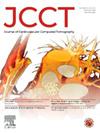Comparison of dual-energy iodine and standard subtraction methods for myocardial extracellular volume quantification using cardiac computed tomography
IF 5.8
2区 医学
Q1 CARDIAC & CARDIOVASCULAR SYSTEMS
引用次数: 0
Abstract
Background
Computed tomography (CT)-derived extracellular volume fraction (ECV) quantifies myocardial fibrosis noninvasively, comparable to cardiovascular magnetic resonance. The conventional subtraction method (ECV-conv) requires dedicated pre- and post-contrast acquisitions, while the dual-energy spectral method (ECV-spec) uses only the post-contrast phase. We aimed to compare these methods in patients undergoing CT planning for transcatheter aortic valve replacement (TAVR).
Methods
We prospectively included patients undergoing CT-TAVR evaluation on a dual-energy dual-layer detector scanner. Baseline pre-contrast and equilibrium delay phase (at 5 min) prospectively ECG-triggered acquisitions were co-registered for ECV-conv calculation. Equilibrium phase spectral iodine maps were derived for ECV-spec measurement and compared with ECV-con maps using a mid-septal and a global mid-ventricular region of interest.
Results
Overall, 78 patients (53 % female, mean age 77 years) were analyzed. There was a minor overestimation in global measurement by ECV-spec (31.8 ± 4.6 % vs 30.3 ± 5.3 %, p = 0.023. However, there were no significant differences between both methods for the mid-septal measurement (ECV-conv = 30.4 ± 5.3 % vs ECV-spec = 31.0 ± 5.6 %, p = 0.196).). Both methods demonstrated comparable 95 % limits of agreement, with a strong correlation for mid-septal (r = 0.75, p < 0.0001) and a moderate correlation for global measurements (r = 0.51, p < 0.0001).
Conclusions
Myocardial CT-ECV estimation using dual-energy spectral maps was comparable to the conventional subtraction method without the need of a pre-contrast acquisition. This approach may help reduce imaging and processing times, as well as minimize radiation exposure.
双能碘法与标准减法在心肌计算机断层成像中心肌细胞外体积定量的比较。
背景:计算机断层扫描(CT)衍生的细胞外体积分数(ECV)无创量化心肌纤维化,可与心血管磁共振相媲美。传统的减法(ECV-conv)需要专门的对比前和对比后采集,而双能谱法(ECV-spec)只使用对比后阶段。我们的目的是比较这些方法在接受CT计划经导管主动脉瓣置换术(TAVR)患者中的应用。方法:我们前瞻性地纳入了在双能量双层探测器扫描仪上进行CT-TAVR评估的患者。基线对比前和平衡延迟阶段(5分钟)预期的心电图触发采集被共同登记用于ECV-conv计算。平衡相谱碘图用于ECV-spec测量,并与ECV-con图进行比较,使用中间隔和全局中心室区域。结果:总共分析了78例患者(53%为女性,平均年龄77岁)。ECV-spec在全局测量中有轻微的高估(31.8±4.6% vs 30.3±5.3%,p = 0.023)。然而,两种方法在中隔测量方面没有显著差异(ECV-conv = 30.4±5.3% vs ECV-spec = 31.0±5.6%,p = 0.196)。两种方法都显示出95%的一致性限,与中间隔有很强的相关性(r = 0.75, p)。结论:使用双能谱图进行心肌CT-ECV估计与传统的减法方法相当,而无需进行对比前采集。这种方法可能有助于减少成像和处理时间,并尽量减少辐射暴露。
本文章由计算机程序翻译,如有差异,请以英文原文为准。
求助全文
约1分钟内获得全文
求助全文
来源期刊

Journal of Cardiovascular Computed Tomography
CARDIAC & CARDIOVASCULAR SYSTEMS-RADIOLOGY, NUCLEAR MEDICINE & MEDICAL IMAGING
CiteScore
7.50
自引率
14.80%
发文量
212
审稿时长
40 days
期刊介绍:
The Journal of Cardiovascular Computed Tomography is a unique peer-review journal that integrates the entire international cardiovascular CT community including cardiologist and radiologists, from basic to clinical academic researchers, to private practitioners, engineers, allied professionals, industry, and trainees, all of whom are vital and interdependent members of our cardiovascular imaging community across the world. The goal of the journal is to advance the field of cardiovascular CT as the leading cardiovascular CT journal, attracting seminal work in the field with rapid and timely dissemination in electronic and print media.
 求助内容:
求助内容: 应助结果提醒方式:
应助结果提醒方式:


